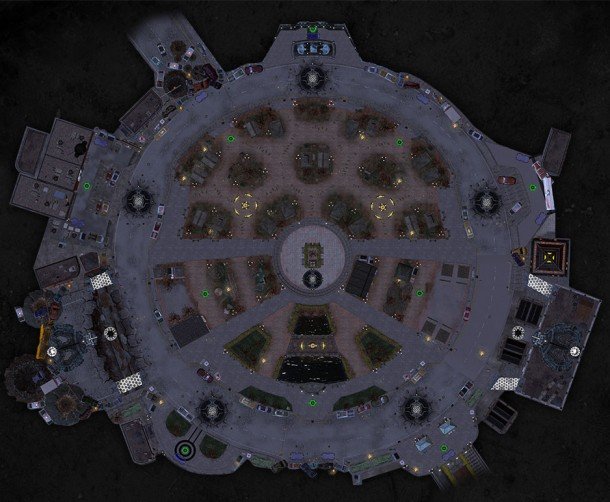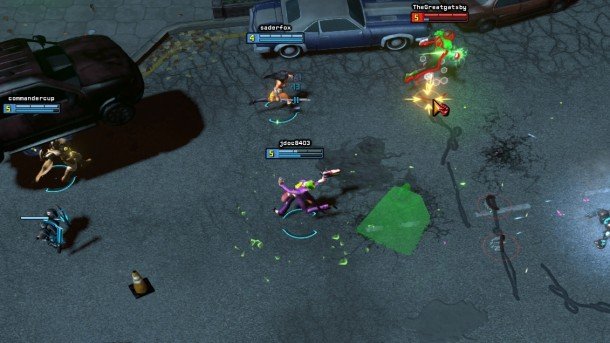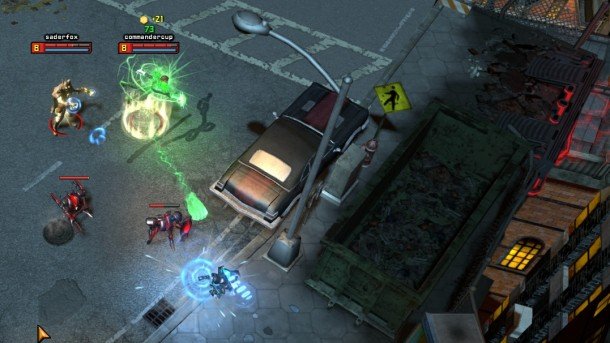
Batman swings on a grappling hook, closing the distance between us. At this range, he can one-shot me with his ultimate. Batman's unlikely ally, The Joker, is also on my heels, throwing presents that spit confetti and toxic gas. I need to get the hell out of here. Both of these champions are higher level and better equipped than me--it's pretty clear I'm about to die. I tap E to fire a glowing green missile. It narrowly misses Batman, exploding a parked car instead. I punch R. A green jet hurtles towards the ground. I'm the Green Lantern and I just dropped a spectral F-22 on Batman. No, this isn't fan fiction. This is Infinite Crisis .
“What does it feel like to be a superhero or supervillain?”
Turbine's heritage is MMOs—it's responsible for Dungeons & Dragons Online, Lord of the Rings Online, and the Asheron's Call series. Infinite Crisis, Turbine's first MOBA, borrows heavily from League of Legends, but it manages to contribute more than just a new roster of characters to the table. With a focus on accessibility and environmental destruction, Infinite Crisis strives to be more than just a clone. Even as an experienced League of Legends player, I appreciated Infinite Crisis' ability recommendations, which let me try a new character without having to read a wiki before I hopped in.
Turbine doesn't do much to hide IC's resemblance to LoL, but the similarities do create instant familiarity with the mechanics. Each hero has four abilities, a passive, and two Stolen Superpowers (Infinite Crisis' version of Summoner Spells). Infinite Crisis even borrows Riot's monetization scheme with two in-game currencies, one earned by playing and one you can purchase with real moolah. In fact, the only map currently available in the closed beta is Gotham Heights, a circular control point level almost identical to League's Crystal Scar map. Fortunately, all of these things work in Infinite Crisis as well as they do in League of Legends.

Five beacons are spaced evenly across Gotham Heights, with minions spawning from beacons that you control. Health packs, stealth pads—think League of Legends' bushes—and speed boosts reinforce the resemblance to the Crystal Scar in LoL. The Infinite Crisis rendition does have a few original elements, including destructible cars, an “urban jungle” and an Orbital Cannon in the center. Capturing the Orbital Cannon locks it for your team as a temporary sixth control point that spawns super minions and drops a meteor into the enemy's jungle.
Destruction is one of Infinite Crisis' defining mechanics. Although it doesn't play the biggest part in Gotham Heights—manifesting as cars and other objects that you can throw or destroy—Turbine considers it a key point of differentiation between other MOBAs. Lead Designer Ryan Bednar says he wants players to be able “to change the map, to change the terrain, [and] to open up paths you couldn't get to before.”

What really stood out to me is Turbine's dedication to creating interesting champions. With access to the entire DC roster, they're really doing everything they can to have characters that you simply can't get anywhere else. They don't have to worry about establishing backstory or building up lore because the DC multiverse is already a thing. Instead, they can focus on making characters like Nightmare Batman—Batman without the humanity of Bruce Wayne, or Gaslight Batman--an especially gadget-crazy alter ego. These characters aren't variations are skins, but discrete champions that have unique abilities.
Creative Director Cardell Karr says that Turbine's goal is to make a game that does “justice to what DC characters and heroes are about.” “What does it feel like to be a superhero or supervillain,” he asks. “How do you find a way to make yourself feel larger than life?”
Keep up to date with the most important stories and the best deals, as picked by the PC Gamer team.
I'd have to say that they've done a good job so far. Interestingly, there aren't traditional support champions that exist only to help a carry. In fact, it almost seems like every single hero can be a carry. I'm not sure what this means for competitive play, but I know that I've never met a person that actually enjoys supporting. Every character that I've played feels powerful. Even the auto-attack animations convey a sense of force. Cyborg visibly recoils with each shot from his cannon arm.

Even the auto-attack animations convey a sense of force.
Infinite Crisis' accessibility is a great asset. Turbine has done a great job paring down the mechanics of the genre, removing excess and leaving only the bare necessities. Some players will probably be put off by the reduced complexity, but newbies will have a lot less to worry about when they first start playing. There are no item recipes or item trees. You can upgrade items to increase their properties, but you can't combine them to make something new. Turbines believes this makes Infinite Crisis “inherently more approachable.” At the same time, Turbine wants Infinite Crisis to become an eSport. They realize that a game needs to have depth to be viable as a competitive game.
Kerr promises me that the as-of-yet unreleased Coast City map will be “something that no one's ever seen before,” and a showcase of Infinite Crisis' unique gameplay. I didn't get to try it, but it does sound like it has the potential to make waves in the MOBA space. Don't expect a complete reimagination of the genre—Coast City is a two-lane map with an expanded jungle. It sounds and looks a bit like League of Legends' Twisted Treeline although the inclusion of a giant weapon dropped by something called the Doomsday Device and a full five players does sound pretty spectacular.

I'm not yet sure if Infinite Crisis has the potential to actually take on League of Legends or Dota 2, but I know that I had a lot of fun playing as heroes that exist outside of the game. Anyone remotely interested in DC superheroes should take the time to try Infinite Crisis, you just might be surprised by how well it plays. Apply to the closed beta for your chance to get in on the action before the game launches later this year.

